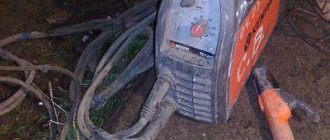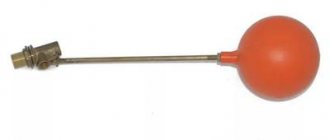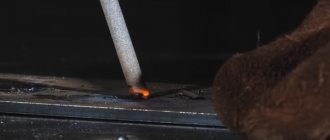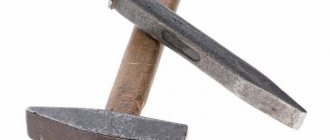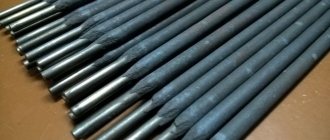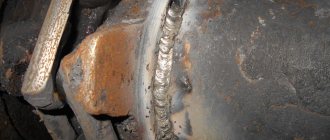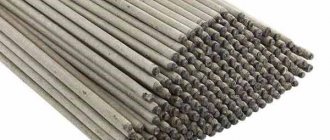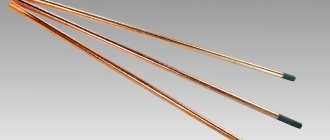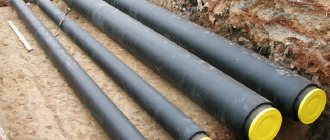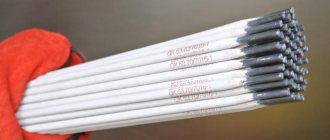Home / Electrodes
Back
Reading time: 2 min
0
2036
For welding work, you cannot do without an electrode. Today the market offers more than two hundred types, which are difficult to understand. After all, each rod is designed for a separate type of work.
The seam of gas or water pipes must be especially strong. With the help of which electrodes this can be achieved, we will talk to you in this article.
How to ensure the reliability of the weld so that it can withstand high pressure? What should be the composition of the rod for tubing (tubing) pipes?
In our review, we will help a beginner understand a wide selection of electrodes.
- Welding electrode for gas welding
- The best way to weld a heating system
- What rods will be needed to install a water pipeline?
- How to weld tubing pipes
- Conclusion
Selecting Electrodes
Among the variety of available consumables, you should immediately begin to solve the problem of which electrodes are best for welding pipes. In particular, this will depend on the type of specific work, further operation of the product, and the characteristics of the material from which the pipes are made.
The choice depends significantly on the cross-sectional size of the pipes being connected. For example, when deciding which electrode to weld a 32 mm pipe, you will have to take into account that it is made of low-density polyethylene, which has its own nuances. Such pipes are used, for example, for plumbing work in private country houses, for supplying drinking or technical water.
Recommended electrodes for pipes, the peculiarity of which is the supply of gas through them, are OK-46, UONI-13/55. They contain elements such as manganese, phosphorus, sulfur, and silicon. Welding tools OK-46, which have rutile coating, can be considered universal consumables. They can be used for gap welding.
When welding connections from critical pipes, we can recommend the MTG-01K brand. Its advantages include arc stability, ease of removal of slag crust, and low metal spattering.
If the task is to weld a water pipeline, then separation should follow depending on what material the pipes are made of. MH-5 is suitable for copper pipes. For pipes made of stainless steel, you will need NZh-13 electrodes, and for cast iron round parts - MNCh-2.
Calculation of boiler parameters and selection of materials
Diagram of a water boiler.
Before proceeding directly to the construction of heating equipment, it is necessary to carry out some calculations to make it possible to construct a boiler that would cope with its main task - heating the room - as efficiently as possible. In this case, the following data should be taken into account: the volume of the room that will be heated during the cold season; materials used in the construction of the building; the presence of thermal insulation layers; the volume of water required to ensure high-quality heat exchange.
Next, you should select a boiler based on the fuel used and calculate its required volume. In this case, you should take into account not only the cost of the unit itself, but also the price of fuel, the possibility of bringing it to the house or delivery (solid fuel).
When choosing a material for the manufacture of a boiler, it is necessary to take into account the thickness of the metal blank from which the walls of the unit will be constructed and its quality.
It is recommended to use metal whose thickness is more than 3 mm. It is especially important to use high-quality metal when creating a combustion chamber. In this case, it is best to use a heat-resistant alloy, which will allow the heating boiler to be used for a long time.
When choosing a material, it is also necessary to take into account the ease of welding and the strength of the welds. Low-carbon steel with a carbon content of no more than 0.25% fits these criteria perfectly.
For heating
The choice of which electrodes are best for welding heating pipes must be taken very seriously, since these parts must withstand high pressure and pressure. Such repairs are carried out for many years, so when deciding which electrodes are best for welding heating pipes, preference should be given to those that will ensure the durability of the connection.
Heating pipelines have a significant transverse size, so great importance is attached to the cross-sectional size of the electrodes used to connect them. This will affect the quality of the seam and the consumption of metal. The thickness of the coating of the internal rods is also of increased importance.
Specifically, as electrodes used to connect heating pipes, we can primarily recommend such popular brands as UONI 13/45, which have a diameter of three millimeters. Their advantage is that they have a large coating amount, making it possible to weld steel with a high carbon content. Brands of consumables such as TsL-20 and E09H1MF are also suitable.
When welding steel with high heat resistance with these types of electrodes, a strong seam is obtained that successfully withstands high pressure. If the pipes are made of alloy, high-carbon or stainless steel, then TsL-9 electrodes, which have the main type of coating, are successfully used.
When planning the connection of pipes intended for the continuous flow of hot water, you can choose MP-3 electrodes. They are coated with rutile coating, and the rod is made of special wire. You can choose a cross-sectional diameter from the range from 3 to 5 millimeters. Work with this grade should be carried out on a short arc, moving the electrode in the direction of surfacing.
Pipe electrodes for heating systems in most cases are of the consumable type. Non-consumable electrodes are used much less frequently. When connecting them end-to-end, the current value is about 100 Amperes, and when connecting them overlapping, at least 120 Amperes.
The best rutile coated welding electrodes
Such rods are used when processing low-carbon and low-alloy steels. The resulting seams are not prone to pore formation and are resistant to hot cracks.
Electrodes with rutile coating have a low metal spatter coefficient, ensure ease of ignition and stable arc burning.
Resanta MP-3
4.9
★★★★★
editorial assessment
93%
buyers recommend this product
See review▶
The main feature of Resant electrodes is the complete absence of cracks after solidification in the metal. The uniformity of the joint prevents the penetration of moisture and ensures high strength of the seam.
The diameter of the rod is 3 mm; it is used to weld material 3-4 mm thick. When using such an electrode, it will be possible to obtain a high-quality seam even on wet, corroded or primed metal.
Advantages:
- minimal splashing;
- ease of re-ignition;
- working with wet surfaces;
- seam strength.
Flaws:
- volumetric slag releases.
Resanta MP-3 is used for welding in conditions of negative temperatures or high humidity.
The resulting seam is resistant to static and shock loads, which will be very useful in the manufacture of large tanks or ship hulls.
Wester MP-3
4.8
★★★★★
editorial assessment
90%
buyers recommend this product
The main features of Wester electrodes include a thin coating and ease of arc re-ignition. This ensures efficient processing of thin sheet metal when frequent stops or long breaks are required.
The electrode diameter is 3 mm, the consumption per 1 kg of deposited metal is 1.7 kilograms. Due to the permissible moisture content in the processed material of 1.5%, such rods can be used to weld moistened and oxidized surfaces.
Advantages:
- easy removal of slag;
- neat seam;
- ease of re-ignition;
- minimal metal spattering.
Flaws:
- requires long-term calcination.
Wester MP-3 are used for manual arc welding of low-carbon steels. They can be used to treat rusty or dirty surfaces.
Quattro Elementi 770-414
4.8
★★★★★
editorial assessment
88%
buyers recommend this product
The electrodes are characterized by a powerful and stable welding arc thanks to the use of a tungsten rod. Their use when processing metal covered with scale or rust prevents the formation of pores and microcracks in the seams.
Element diameter is 2 mm, processing temperature is 170-190°C. High-quality coating and refractory rod guarantee minimal metal loss during operation and resistance to low welding current.
Advantages:
- strong seam;
- smoothness of the connection;
- stable arc burning;
- easy ignition.
Flaws:
- fast consumption.
Quattro Elementi 770-414 are designed for processing thin sheet metal. A good choice for household welding or body repair.
SVEL MR-3C
4.8
★★★★★
editorial assessment
86%
buyers recommend this product
These rods are distinguished by their welding efficiency on short and medium welding arcs. They are recommended for heavy-duty use due to their combustion stability and operation with both direct and alternating current.
The diameter of the rod is 3 mm, which makes it possible to weld metals with a thickness of about 4 mm. Surface treatment is carried out in almost any spatial position.
Advantages:
- deep penetration;
- work in any position;
- low price;
- economical consumption.
Flaws:
- slag splashing.
SVEL MP-3C is worth purchasing for welding in hard-to-reach places or in awkward positions. Electrodes are used when processing critical structures, the inner sides of tanks or wide pipes.
Tubing pipes
A special solution is the solution to the question of which electrodes to weld the tubing pipe with. Due to their responsible purpose, tubing pipes have enhanced requirements for their characteristics regarding operating conditions. They can be successfully welded with MP-3 electrodes. Also for this purpose it is possible to use electrodes UONI 13/45 and 13/55.
Features of welding a heating boiler
Today, housing and communal services have a well-developed heating system for buildings and premises, providing a high level of comfort for their users. In addition to centralized heating, there are ample opportunities to equip housing with individual heating systems, which are actively promoted to the market by well-known manufacturers.
Heating schemes for a private house.
Nevertheless, the need for the design and assembly of heating boilers according to individual projects, completely original and non-standard, still remains. This is due to a number of reasons, including the growing price in recent years for many types of fuel used to operate heating boilers. Not least in this number of reasons are the peculiarities of the construction of private houses, their remoteness from centralized heating networks and the geographical proximity (ease of obtaining) of one or another type of fuel.
When starting to equip any room, you should carefully evaluate all possible factors and decide in advance what type of boiler, what configuration, what layout of heating pipes and placement of radiators will be used in this room.
Purpose and types of heating boilers
Diagram of a combined heating boiler.
Today there is a wide variety of heat generators, the designs of which use water as the main coolant. Water heating boilers differ in the number of working circuits involved in the heat exchange process and in the type of fuel (heating method).
Depending on the number of circuits, the boiler can be either single-circuit or double-circuit. Single-circuit units circulate heated liquid only in the room heating system. Double-circuit devices not only heat water for heating pipes and radiators, but also provide hot water to the building's plumbing system.
According to the type of fuel used (method of heating water in the system), heating boilers are divided into the following groups:
- Solid fuel boilers. Solid combustion sources are used as fuel - coal, coke, peat, firewood, pellets (combined fuel pellets), less often - wood chips, sawdust, brushwood, sunflower husks, etc.
- Gas boilers. To produce heat, they burn gaseous fuel, most often natural gas - propane-butane or methane.
- Liquid fuel boilers. They operate on liquid fuel, mainly diesel fuel or fuel oil.
- Electric boilers. Devices of this type are designed to heat a coolant liquid by transferring heat from a heating element (heating element) heated by electric current. Electric boilers used in the hot water supply system are also called electric water heaters (electric boilers).
- Combination boilers. These are devices that can burn both solid and gaseous fuels to produce heat for rooms. At the same time, they are equipped with special automation for switching from one type of fuel to another.
Nuances of technology
Before starting the final connection of the ends of the pipes, it is necessary to make several tacks along their diameter with the same electrodes that are planned to be used for welding. For a small diameter, four tacks will be sufficient; as the diameter increases, the number of tacks should be increased. This will help fix the connected ends of the pipes to each other.
When joining pipe ends, a continuous seam must be placed at the joint. To do this, the electrode should be guided along the diameter without leaving the surface. In order to heat the metal more deeply, the electrode is moved not perpendicular to the surface, but at an angle of 30-60 degrees so that the weld pool moves behind it.
If a rotary joint is welded, for example, when changing the direction of the pipeline, it is recommended to use a special device called a rotator. The convenience of its use lies in the fact that after the parts are secured in the desired position, there is free access to all sides of the pipes. In the absence of such a device, first a pair of seams are placed on one side of the circle, and then the product is unrolled and the connection is made on the other sides in stages.
When welding non-rotating joints, the connection starts from the bottom while sequentially moving the electrode upward.
How to make the right seam
To make a high-quality seam, proper preparation of the pipe for welding is necessary. The quality of the pipe edge is decisive for a durable and airtight seam.
For example, for butt welding, the pipe cut must be strictly at a right angle. Before starting work, it is thoroughly cleaned with sandpaper 1 cm from the edge of the pipe, then oil, paint, metal dust are removed and degreased.
The welding technique depends on the cross-sectional shape, thickness and diameter of the pipes being connected. Simple round pipes for heating systems are welded using a simple continuous seam, moving the electrode along the surface of the pipe until the two pieces are completely welded.
For relatively thin pipes (up to 6 mm), a two-layer weld is suitable; for thicknesses from 6 to 12 mm, three-layer welding is used. Massive and thick pipeline fragments are connected with four or more seams.
The seams are performed alternately, one after the other. The next seam can be started only after the previous one has cooled. To achieve a high-quality and beautiful seam, you need to periodically remove the slag formed at the welding site by lightly tapping the pipe with a hammer.
Features of welding rotary and non-rotary joints
To make a high-quality rotary joint (where two pipes are connected at a certain angle), you can use a special rotator, which fixes and provides the most convenient access for the welder.
In the absence of a device, you will have to rotate the pipe manually, using an electrode to treat a section of the pipe cross-section of 60-110 degrees.
When making a rotary joint manually, the diameter of the pipes is first welded 2/4 from the outside in two layers, then unfolded and the joint is welded using all three or four layers.
A fixed joint is much easier to make: combine two pipe fragments and make several welding points (for example, in the form of an imaginary cross, or only on two opposite sides). Cook the pipe, starting from the bottom point, moving the electrode to the top section.
How to check the connection reliability
The tightness of the weld can only be checked in one way - pass water or gas under pressure through the pipe and check visually for leaks of the working medium. For example, if you are welding pipes for a heating system, you can attach a section of pipe to the system and fill it with water. If no drops of water appear on the weld area, the welding is done efficiently.
